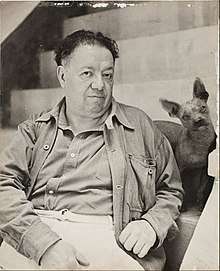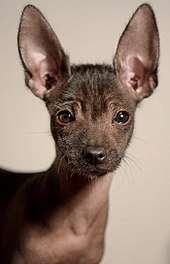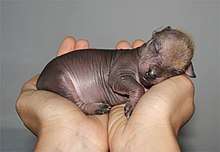Xoloitzcuintle
The Xoloitzcuintle (/ʃoʊloʊiːtsˈkwiːntleɪ/), or Xolo, also known as the Mexican hairless dog, is one of several breeds of hairless dog. It is found in toy, miniature, and standard sizes. The Xolo also comes in a coated variety and coated and hairless can be born in the same litter. It is characterized by its lack of hair, wrinkles, and dental abnormalities. In Nahuatl, from which its name originates, its name is xōlōitzcuintli [ʃoːloːit͡sˈkʷint͡ɬi] (singular)[1] and xōlōitzcuintin [ʃoːloːit͡sˈkʷintin] (plural).[1] The name comes from the god Xolotl and itzcuīntli [it͡skʷiːnt͡ɬi], meaning dog in Nahuatl.[1]
| Xoloitzcuintle | |||||||||
|---|---|---|---|---|---|---|---|---|---|
.jpg) A lighter Xoloitzcuintle | |||||||||
| Other names | Mexican hairless dog, Xoloitzcuintli | ||||||||
| Common nicknames | Xolo | ||||||||
| Origin | Mexico | ||||||||
| |||||||||
| Notes | National dog of Mexico | ||||||||
| Dog (domestic dog) | |||||||||
Lineage
A 1999 genetic study using mitochondrial DNA found that the DNA sequences of the Xoloitzcuintle were identical to those of dogs from the Old World. This early study did not find a close genetic relationship between Xoloitzcuintle and the Chinese Crested Dog, another hairless breed that is cited by the American Kennel Club as an ancestor to the Xoloitzcuintle.[2]
In 2018, an analysis of DNA from the entire genome indicated that domesticated dogs entered North America from Siberia for 4,500 years and were isolated for the next 9,000 years. After contact with Europeans, these lineages were replaced by Eurasian dogs and their local descendants, like the Xoloitzcuintle. The pre-contact dogs exhibited a unique genetic signature that is now gone.[3]
Their phenotype is a consequence of canine ectodermal dysplasia caused by a mutation on the Foxl3 autosomal gene.[4]
History
.jpg)
Archaeological evidence has been found in Colima dating similar dogs to over 3500 years ago.[5] Long regarded as guardians and protectors, the indigenous peoples believed that the Xolo would safeguard the home from evil spirits as well as intruders. Ceramic representations of the Xolo, known as Colima Dogs, have been found in hundreds of burial sites.[6] In ancient times the Xolos were often sacrificed and then buried with their owners to act as guide to the soul on its journey to the underworld. They have been found in burial sites of both the Maya and the Toltec.[7] These dogs were considered a great delicacy, and were consumed for sacrificial ceremonies–including marriages and funerals.[8] Most likely, these pre-European dogs originated as spontaneous hairless mutations of indigenous American dogs. Hairlessness may have conferred a survival advantage in tropical regions. Indigenous peoples of Mexico had Xolo dogs as home and hunting companions, and today they are still very popular companion dogs. Their value in ancient native cultures is evidenced by their frequent appearance in art and artifacts.

Pre-European Xolos were considered sacred dogs by the Aztecs, Toltecs, Maya, and other groups. They were also useful companion animals. According to Aztec mythology, the god Xolotl made the Xoloitzcuintli from a sliver of the Bone of Life from which all mankind was made. Xolotl gave this gift to Man with the instruction to guard it with his life and in exchange it would guide Man through the dangers of Mictlan, the world of Death, toward the Evening Star in the Heavens. Some people in Mexico continue to believe this breed has healing qualities. The Aztecs also raised the breed for their meat. Sixteenth-century Spanish accounts tell of large numbers of dogs being served at banquets.[9] Aztec Merchant feasts could have 80–100 turkeys and 20–40 dogs served as food.[10] When these two meats were served in the same dish, the dog meat was at the bottom of the dish, either because it was held in higher regard or because it was increasingly considered a step above cannibalism.[10]
The Aztecs consumed few domesticated animals like Xolos or turkey.[10] Over 90% of the bones found at archeological sites are of deer that were hunted.[10]
The breed is not historically well known in the United States. As a result, the Xolo has been mistaken for the mythical Chupacabras of Mexico.[11]
On August 12, 2016, the Mayor of Mexico City Miguel Ángel Mancera designated the Xoloitzcuintle as a "cultural heritage and symbol" of Mexico City.[12]
Registry
Fédération Cynologique Internationale (FCI)
Despite the Xolo's more than 3000-year history in Mexico, the breed did not receive any official notice in its homeland until the 1950s. The FCI, founded in 1940, was not prepared to declare the Xolo an official purebred at that time. According to breed historian Norman Pelham Wright, author of The Enigma of the Xoloitzcuintli, Xolos began to turn up at Mexican dog shows in the late 1940s. Although they were recognized as indigenous specimens of a native breed, interest in them was minimal at that time, because information was scarce and no standard existed by which to judge them. Within a decade the FCI realized that the breed would become extinct if drastic action were not taken to save it. This led to the widely publicized Xolo Expedition of 1954. With the official sanction of the FCI, Wright and a team of Mexican and British dog authorities set off to discover if any purebred Xolos still existed in remote areas of Mexico.
Eventually ten structurally strong Xolos were found and these dogs formed the foundation of Mexico's program to revive the breed. A committee headed by Wright authored the first official standard for the breed; on May 1, 1956, the Xolo was finally recognized in its native land and, as Mexico is a member of the FCI, worldwide.
American Kennel Club (AKC)

Xolos were among the first breeds recorded by the American Kennel Club (AKC). A Mexican dog named 'Mee Too' made breed history as the first AKC-registered Xolo in 1887. 'Chinito Junior', bred and owned by Valetska Radtke of New York City, became the breed's only AKC champion to date. He earned his title on October 19, 1940.
In 1959, the Xolo was dropped from the AKC stud book due to the breed's scarcity and perceived extinction. The Xoloitzcuintli Club of America (XCA) was founded in October 1986 to regain AKC recognition for the breed. On May 13, 2008, AKC voted to readmit the breed to its Miscellaneous Class starting January 1, 2009. The XCA is the official parent club for the breed, founded on October 26, 1986, for the purpose of regaining AKC recognition for the Xoloitzcuintli. The founding members voted unanimously to recognize all three sizes (toy, miniature and standard) and both varieties (hairless and coated) at their initial meeting. Since then, the XCA has compiled a stud book modeled on requirements for eventual AKC acceptance, held an annual independent specialty show, published a quarterly newsletter, The Xolo News, and maintained an active national rescue network, National Xolo Rescue (known before 2009 as The Xolo Rescue League[13]). Since January 1, 2007, FSS registered Xolos have been eligible to compete in AKC performance events. The breed was moved into the AKC Studbook in December 2010 and has been eligible to be shown in the AKC Non-Sporting group since January 1, 2011.[14]
The first AKC Group Winning Xolo was Bayshore Mole who won a Group 4 placement February 2, 2011, and this was followed by his littermate Bayshore Georgio Armani receiving back to back group placement. On August 8, 2011, Bayshore Georgio Armani became the first Xolo to be named Best in Show in AKC competition. Bayshore Mole became the first Xolo to win back to back Best in Shows on September 3 and 4, 2011. Both dogs were bred by Bayshore Kennel in Virginia.
In February 2012, the Xolo was one of 6 new breeds to make their first appearance at the Westminster Kennel Club Dog Show.
Characteristics
Appearance
The breed ranges in size from about 10 to 55 lb (5 to 23 kg). The height is 9 to 26 inches (23-67 cm). Similar in appearance to a Pharaoh Hound, with a sleek body, almond-shaped eyes, large bat-like ears, and a long neck, the Xolo is notable for its dominant trait of hairlessness.[16] The dominant hairless trait originated in this breed as a spontaneous mutation thousands of years ago. The recessive expression of the trait will produce a coated variety, which is genetically inseparable from the hairless, as the homozygous appearance of the hairless mutation is fatal to the unborn pup.[17] Most litters contain both hairless and coated puppies. The coated variety, covered with a short, flat dense coat represents the original form of the dog, prior to the occurrence of the spontaneous hairless mutation.[18] The hairless variety is completely hairless on the body, with many dogs exhibiting a few short hairs on the top of the head, the toes, and the tip of the tail. Most hairless dogs are black or bluish-gray in color. The allele responsible for the Xolo's hairlessness also affects the dog's dentition: Hairless Xolos typically have an incomplete set of teeth while the dogs of the coated variety have complete dentition.
The Xolo is moderate in all aspects of its appearance, conveying an impression of strength, agility, and elegance. Xolo body proportions are rectangular, slightly longer in total body length than the height measured at the highest point of the withers (top of the shoulders). The breed occurs naturally in two varieties, hairless and coated. Hairless Xolos are the dominant expression of the heterozygous Hh hairless trait.[19] Coated Xolos (hh) are the recessive expression, and breeding hairless to coated or hairless to hairless may produce pups of either or both varieties. Breeding coated to coated will only produce coated pups because they are recessive to the hairless trait and do not carry the dominant H gene.
Both varieties occur in all hair or skin colors, and often marked, splashed, or spotted. The most common colors are various shades termed black, grey, bronze,yellowish-blonde, blue, and red. The breed occurs in a range of sizes, which breeders have standardized into three designations.
Temperament
The Xoloitzcuintli's 'primitive' temperament (very high intelligence, sensitivity, high energy, inquisitiveness, strong hunting, and social instincts) is apparent because the breed's temperament was not modified overall by selective breeding in their native history in Mexico. This has also ensured a sturdy physical nature and vigorous health generally innate in both coated and uncoated Xolos. Adult Xolos are frequently noted for their calm demeanor, although puppies can be extremely energetic, noisy, and very oral until they reach maturity (after 2 years old) and do not bark much, after which they tend to settle down and become more calm. Inadequately supervised or exercised Xolos can become escape artists, climbing and jumping fences to chase. Many individuals of this breed can possess guard dog ability and will not back down from a fight. At the same time, adult dogs, when they are raised properly, can become steady, well-behaved, and affectionate companions.
Though physically grown at one year, many dog breeds including Xolos, are not 'emotionally mature' until around two years. Like active breeds such as terriers, Xolos need calm, consistent, and loving obedience training and regular socialization during their growing years. Well-raised Xolos bond strongly with their owners, becoming highly devoted to their families while frequently choosing one specific family member as favorite.

Anyone considering acquiring a Xolo should expect to spend time educating themselves in positive reinforcement dog training techniques, and, ideally, should have prior experience with active and intelligent dog breeds. A spacious, well-fenced, and safe physical environment is desirable for this breed. Daily walks are ideal for exercising most toy-sized Xolos, however more stimulating physical and mental exercise is advised for larger and more active individuals. Behavior problems in Xolos are typically a result of a dog receiving inadequate or inconsistent supervision, as well as inadequate exercise and mental stimulation. The Xoloitzcuintli is a social dog that should not, in most cases, be an "only dog". It does not do well when kept as an outside-only dog. This is a breed that is at its best when it is made part of the family, receiving regular interaction and socialization with its humans (and other dogs, whether present in the home or as regular playmates).
Health
The Xolo has been developed by natural selection for thousands of years, and is therefore generally not prone to health and structure problems as other dog breeds more modified by human selection efforts. Xolos came from tropical climates and are not suited for outdoor life in colder temperate and northern climates; they should be considered an indoor dog breed. They need bathing, light grooming, and skin care as with other dogs of similar physical type, or acne can result. Most skin problems arise from poor breeding, neglect, or over-bathing and over-lotioning, stripping natural protections and clogging pores.[20][21]
In popular culture

- Xolos are depicted in some of Mexican artist Frida Kahlo's paintings.[22]
- Diego Rivera's large murals depicting the history of Mexico in the Palacio Nacional in Mexico City feature numerous Xolos.
- Xolo was featured in Royal de Luxe's street theater performances in Guadalajara, Mexico (November 2010), Nantes, France (May 2011), and Liverpool (April 2012). A huge puppet of the dog accompanied the company's famous Giants.
- The Xolo was featured for the first time at the Westminster Dog Show in 2012.
- A Xolo photograph won 1st place in the "Animal Kingdom" Life Framer competition (2015).[23]
- A Xolo named Dante is featured in the Disney/Pixar film Coco.
- Persephone, from the 2018 film Show Dogs is a Xoloitzcuintle.
- In one famous urban legend, a woman brings home what she believes to be a Mexican Hairless Dog from a trip to Mexico, only for it to turn out to be a rabid sewer rat.[24]
- The Xoloitzcuintle is the symbol and mascot of Club Tijuana – Xolitzcuintles de Caliente, a professional soccer club.
- Museo El Carmen in Mexico City exhibited a show titled Xolos, compañeros de viaje (Xolos, travel companions) in 2019–20 of more than 100 artifacts – ceramics, remains, and artworks – overviewing the importance of the Xoloitcuintle in Mexican heritage.[25]
See also
References
- Nahuatl Dictionary. (1997). Wired Humanities Project. University of Oregon. Retrieved September 1, 2012, from link
- C. Vilà, J.E. Maldonado, and R.K. Wayne. Phylogenetic relationships, evolution, and genetic diversity of the domestic dog. Journal of Heredity (1999) 90(1): 71-77. doi:10.1093/jhered/90.1.71
- Ní Leathlobhair, Máire; Perri, Angela R; Irving-Pease, Evan K; Witt, Kelsey E; Linderholm, Anna; Haile, James; Lebrasseur, Ophelie; Ameen, Carly; Blick, Jeffrey; Boyko, Adam R; Brace, Selina; Cortes, Yahaira Nunes; Crockford, Susan J; Devault, Alison; Dimopoulos, Evangelos A; Eldridge, Morley; Enk, Jacob; Gopalakrishnan, Shyam; Gori, Kevin; Grimes, Vaughan; Guiry, Eric; Hansen, Anders J; Hulme-Beaman, Ardern; Johnson, John; Kitchen, Andrew; Kasparov, Aleksei K; Kwon, Young-Mi; Nikolskiy, Pavel A; Lope, Carlos Peraza; et al. (2018). "The evolutionary history of dogs in the Americas". Science. 361 (6397): 81–85. doi:10.1126/science.aao4776. PMID 29976825.
- Manin, Aurélie; Ollivier, Morgane; Bastian, Fabiola; Zazzo, Antoine; Tombret, Olivier; Equihua Manrique, Juan Carlos; Lefèvre, Christine (October 2018). "Can we identify the Mexican hairless dog in the archaeological record? Morphological and genetic insights from Tizayuca, Basin of Mexico" (PDF). Journal of Archaeological Science. 98: 128–136. doi:10.1016/j.jas.2018.08.008. ISSN 0305-4403.
- "This Hairless Mexican Dog Has a Storied, Ancient Past". National Geographic News. 2017-11-22. Retrieved 2020-01-06.
- "vessel in form of a dog". Indianapolis Museum of Art Online Collection. Retrieved 2020-01-06.
- "Mexico is in love with a $5,000 hairless dog that often wins competitions — in the ugliest category". Los Angeles Times. 2017-04-28. Retrieved 2020-01-06.
- "Xoloitzcuintli Club of America, Inc. - ABOUT XOLOS".
- Coe, Sophie D. (1994) America's first cuisines ISBN 0-292-71159-X
- Aguilar-Moreno, M. (2006). Handbook to life in the Aztec world. Oxford University Press: USA. p.329 ISBN 978-0-19-533083-0
- "Mythical chupacabra found?". CNN. 1 September 2009. Retrieved 12 May 2010.
- "Xoloitzcuintle, el perro azteca, patrimonio de la CDMX". Excélsior (in Spanish). 2016-08-12. Retrieved 2020-01-06.
- National Xolo Rescue Archived June 26, 2010, at the Wayback Machine at the XCA website
- Xolo News Archived 2010-01-13 at the Wayback Machine at AKC.org
- "GCH Bayshore's Giorgio Armani Leads the Way for Xoloitzcuintli Breed". Purina ProClub. Retrieved 11 April 2015.
- "Inheritance and Breeding Results of Mexican Hairless Dogs" Archived 2011-07-15 at the Wayback Machine, Laboratory Animals, 1993.
- "FCI-Standard N° 234: XOLOITZCUINTLE (Hairless Variety & Coated Variety)". Fédération Cynologique Internationale. 2011-02-16. Archived from the original on 2013-11-01. Retrieved 2012-08-20.
- "xoloitzcuintliclubofamerica.com". Archived from the original on May 27, 2008.
- Drogemuller, C.; E. K. Karlsson, M. K. Hytonen, M. Perloski, G. Dolf, K. Sainio, H. Lohi, K. Lindblad-Toh, and T. Leeb. "A Mutation in Hairless Dogs Implicates FOXI3" Archived 2011-07-08 at the Wayback Machine. Science 321 (5895):1462, 2008.
- Kimura, T; Doi, K. "Spontaneous Comedones on the Skin of Hairless Descendants of Mexican Hairless Dogs." Experimental Animals, 45(4), pp 377-384 1996
- Kimura, T. "Studies on Development of Hairless Descendants of Mexican Hairless Dogs and Their Uses in Dermatological Science." Experimental Animals, 45(1), pp 1-13 1996
- "Frida Kahlo and her Itzcuintli Dogs".
- "Animal Kingdom Winners - LIFE FRAMER".
- https://ils.unc.edu/~sturm/storytelling/cuecards/mexicanpet.htm
- "Museo de El Carmen inaugura expo sobre los xolos por el Día de Muertos". www.milenio.com. Retrieved 2020-01-07.
Further reading
- The Xolo Handbook. Xoloitzcuintli Club of America, 1999.
External links
![]()
- Xolo Sanctuary, a non-profit sanctuary with mission to preserve the Xoloitzcuintli.
- The Xoloitzcuintli Club of America (XCA), AKC Xolo parent club.
- "New AKC Recognized Breed: The Xolo", Cesar's Way, July 2011
- American Kennel Club (AKC) Xoloitzcuintli information page
- URCANIS breedingclub of Sweden
- Mexican dog breeds list| Hairless Mexican Xoloitzcuintli dog| chihuahua
.jpg)